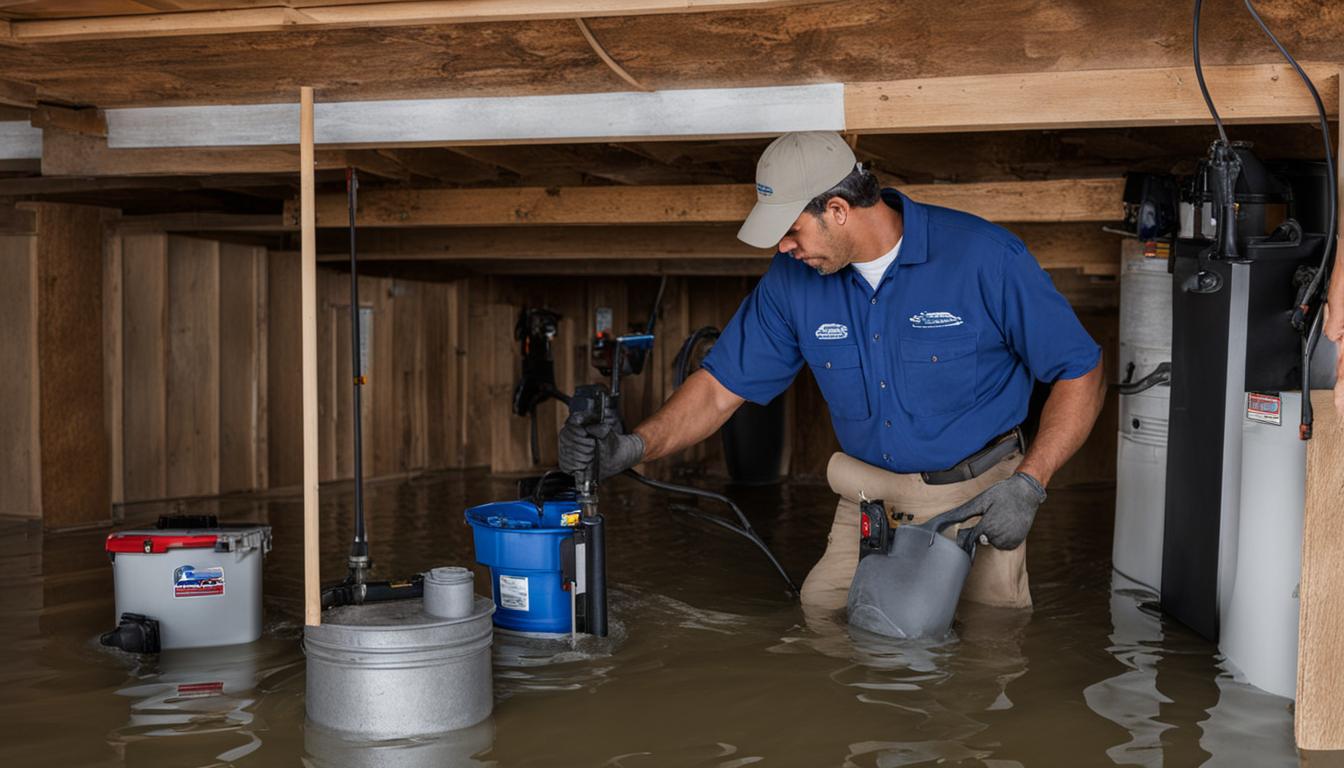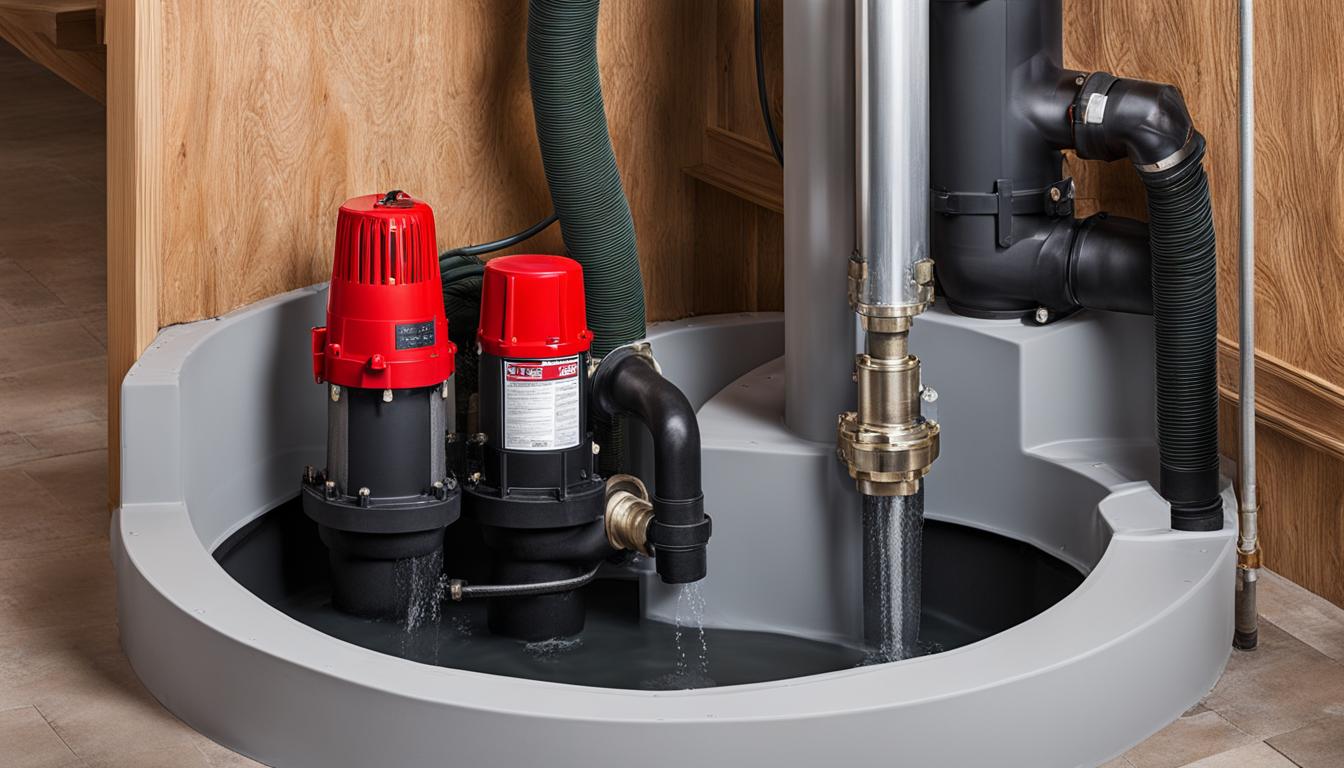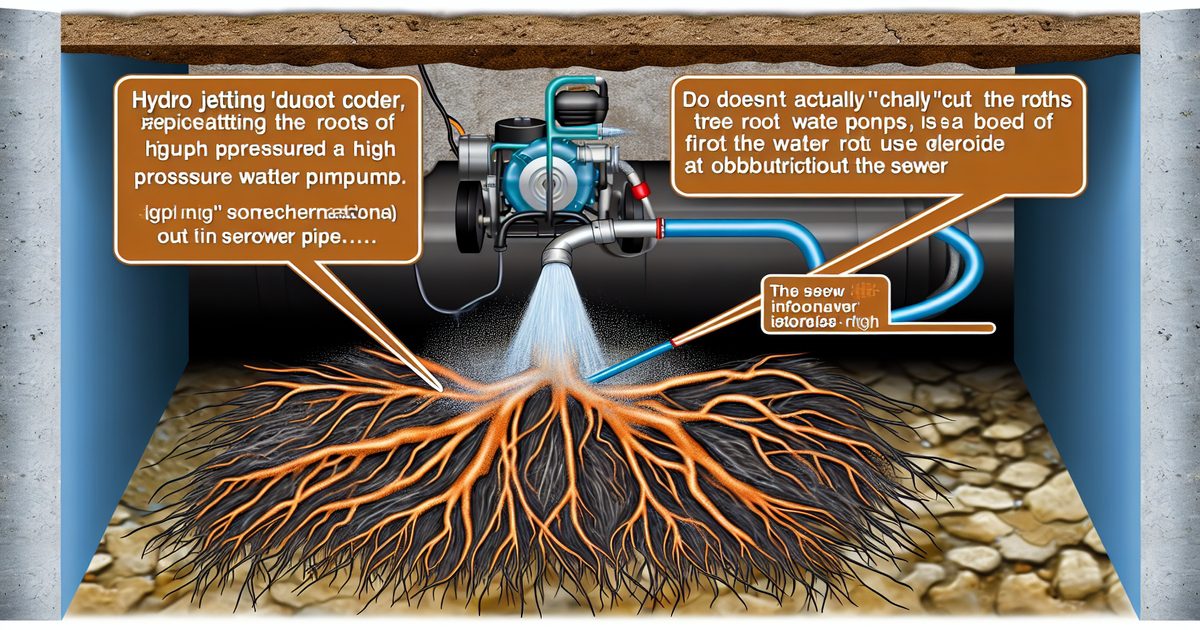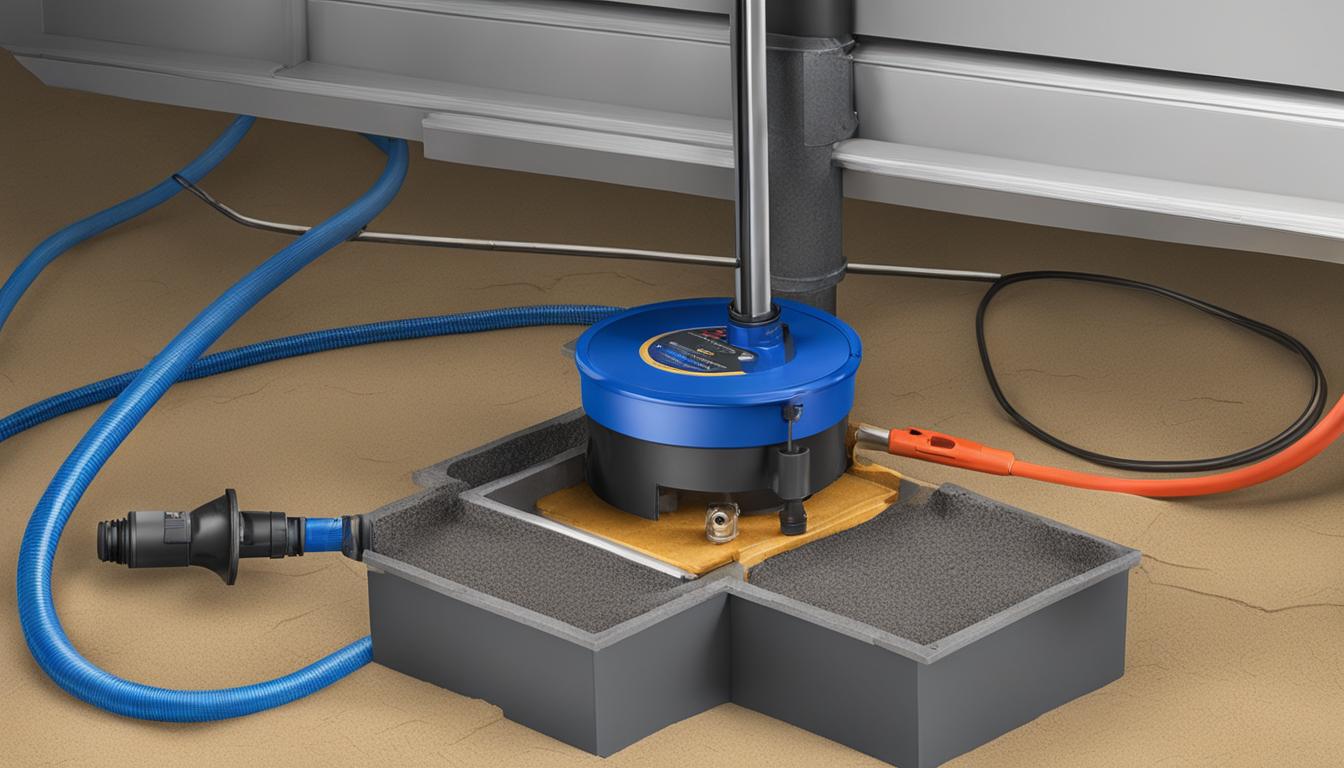When it comes to installing a sump pump, it’s crucial to take into account the electrical considerations that come with it. Proper electrical setup, sump pump wiring, power requirements, and safety standards are all important factors that need to be considered for optimal functionality. Whether you’re doing it yourself or hiring a professional, understanding these electrical considerations will help ensure a safe and reliable installation.
Key Takeaways
- Proper electrical setup is essential for a safe and reliable sump pump installation.
- Sump pump wiring should follow best practices and safety standards.
- Determining the appropriate power requirements for your sump pump is crucial.
- Safety should always be a top priority during sump pump electrical work.
- Power efficiency measures can help reduce energy costs and benefit the environment.
Understanding the Electrical Setup for Sump Pump Installation
Before beginning the installation process, it’s important to have a thorough understanding of the electrical setup needed for a sump pump. This ensures optimal performance and minimizes the risk of electrical hazards. Here, we’ll guide you through the key components required for safe and reliable operation of your sump pump.
Necessary Components
The first and most crucial component is a dedicated circuit breaker. A dedicated circuit breaker ensures that your sump pump has its own circuit, separate from other electrical devices in your home. This means that any electrical issues that occur in the rest of your home will not affect your sump pump’s operation. It’s important that the circuit breaker is correctly sized for the pump’s power requirements, which we’ll discuss further in section 4.
Another essential component is a ground fault circuit interrupter (GFCI) outlet. This type of outlet automatically shuts off power in the event of an electrical fault, reducing the risk of electric shock. Sump pumps are typically installed in areas that are prone to moisture, so having a GFCI outlet is critical for safety.
A disconnect switch is another necessary component. This switch allows you to easily turn off power to the sump pump for maintenance or repairs without having to shut off power to your entire house.
Proper Wiring
Once the necessary components are in place, proper wiring is crucial for safe and reliable operation of your sump pump. We recommend using a licensed electrician to ensure correct wiring. However, if you choose to do it yourself, make sure to follow safety standards and guidelines for sump pump wiring, which we’ll discuss further in section 3.
Testing and Maintenance
After installation, it’s important to test your sump pump to ensure it’s functioning properly. You should test it at least once a year, or before the rainy season. Additionally, regular maintenance, such as cleaning the pump and checking for debris, can help prolong its lifespan and prevent breakdowns.
A properly set up and wired sump pump is crucial for avoiding potential electrical hazards and ensuring efficient operation. With the right knowledge and guidance, you can confidently install and maintain your sump pump’s electrical setup.
Sump Pump Wiring: Best Practices for a Safe Installation
When it comes to sump pump installation, proper wiring is essential for safe and reliable operation. In this section, we’ll cover best practices and safety standards to follow when it comes to sump pump wiring. Whether you’re doing it yourself or hiring a professional, following these guidelines will ensure a secure installation.
Understanding Sump Pump Wiring
Sump pumps typically require a dedicated circuit for power, and the wiring should be rated for outdoor use. The power cord for the sump pump should be plugged into a ground fault circuit interrupter (GFCI) outlet to provide an extra layer of safety against electrical shock.
When wiring the sump pump, it’s crucial to ensure that the wires are properly connected to the correct terminals. Always follow the manufacturer’s instructions and consult an electrical guide if necessary.
Safety Standards for Sump Pump Wiring
When wiring a sump pump, it’s essential to prioritize safety. Here are some safety standards to follow:
- Ensure the power is turned off before beginning any electrical work.
- Wear appropriate safety gear, such as gloves and safety glasses.
- Ensure all wiring is properly grounded to prevent electrical shock.
- Properly label all wires to prevent confusion and ensure proper connection.
Following these safety standards will help prevent accidents and ensure a safe sump pump installation.
Hiring a Professional vs. DIY
If you’re unsure about your electrical skills, it’s always best to hire a professional for sump pump installation. A licensed electrician will ensure that the wiring is installed correctly and up to code, providing peace of mind and reducing the risk of electrical hazards.
However, if you have experience with electrical work and choose to tackle sump pump installation as a DIY project, be sure to follow electrical guidelines and safety standards closely. Always remember to turn off the power before beginning any electrical work, and consult an electrical guide if necessary.
Determining Power Requirements for Your Sump Pump
When it comes to sump pump installation, understanding the power requirements of your specific pump model is crucial. Installing an improperly powered pump can lead to inefficiencies and even potential damage to the pump itself. Here are some installation tips to ensure that your sump pump is running at its best.
Calculating Power Needs
The first step in determining the appropriate power requirements for your sump pump is to calculate the total dynamic head (TDH) of your specific installation. TDH is simply a measure of the resistance that the pump must overcome to move water from the sump pit to its final destination.
To calculate TDH, you’ll need to measure the vertical distance between the water level in the sump pit and the highest point of discharge, as well as the length and diameter of your discharge pipe (if there are any elbows, you’ll need to take those into account as well).
Once you have your TDH, you can use a pump performance curve, typically provided by the manufacturer, to determine the appropriate horsepower and flow rate for your sump pump.
Optimizing Pump Performance
Once you’ve determined the appropriate power requirements for your sump pump, there are a few installation tips that can help optimize its performance.
- Ensure proper wiring: Proper wiring is essential for the safe and reliable operation of your sump pump. Follow the guidelines set forth in our previous section to ensure that your wiring is up to code and your pump is running efficiently.
- Select an appropriate discharge location: Your sump pump should discharge water in a location that is suitable and won’t cause any damage to your property or your neighbor’s.
- Install a check valve: A check valve will prevent water from flowing back into the sump pit once it has been discharged. This can help prevent excessive wear and tear on your pump.
- Consider a backup system: Power outages are common during storms, which is when your sump pump is needed the most. Consider installing a backup system, such as a battery-powered pump, to ensure that your basement stays dry even during power outages.
By following these installation tips and ensuring that your sump pump is powered correctly, you can help guarantee that it will operate at optimal performance for years to come.
Safety Standards for Sump Pump Electrical Work
When it comes to electrical work, safety should always be a top priority. This is especially true when installing a sump pump, which involves working with electricity and water. Whether you decide to take on the project as a DIY enthusiast or hire a professional, it’s important to follow safety standards to ensure a secure installation.
DIY Electrical Work
If you’re planning on doing the electrical work yourself, there are several safety precautions to keep in mind. First, ensure that all power sources are turned off before starting any work. It’s also essential to wear protective gear, such as gloves and safety glasses, to prevent electrocution and injuries.
When working with electrical wiring, make sure to follow the manufacturer’s instructions and use the appropriate tools. It’s also important to avoid using damaged wires or cords, as they can lead to electrical shocks or fires.
Before turning the power back on, double-check all connections to ensure they’re secure and correctly wired. If you have any doubts or concerns, it’s always best to consult a professional.
Professional Installation
While DIY installations can be rewarding, opting for a professional installation can provide additional peace of mind. Professional electricians have the expertise and experience to ensure that the sump pump is installed safely and meets all relevant codes and safety standards.
Professional installation also ensures that all electrical components are correctly sized and installed for optimal performance. Additionally, a professional installation may provide a warranty for the installation, which can give you added protection in case of any issues or malfunctions.
General Safety Standards
Whether you’re doing the work yourself or hiring a professional, there are several general safety standards that should be followed during sump pump installation.
First, avoid operating any electrical equipment near water or in wet locations. It’s also important to properly ground all electrical equipment to reduce the risk of electrocution.
Make sure to follow all local and national electrical codes and regulations. If you have any doubts or questions, consult a professional electrician to ensure that your installation is compliant with all relevant safety standards.
By following these safety guidelines, you can help ensure a safe and secure sump pump installation that will provide reliable performance for years to come.
Circuit Breaker Considerations for Sump Pump Installation
When it comes to sump pump installation, circuit breakers are a critical component to consider, as they protect your pump and wiring from electrical overload. It’s essential to choose the appropriate circuit breaker size, based on the power requirements of your sump pump.
Installing the wrong circuit breaker size could result in a tripped breaker or even a fire hazard. Below is a table to help determine the appropriate circuit breaker size required for your sump pump:
| Sump Pump Power Requirements | Recommended Breaker Size |
|---|---|
| Up to 1/3 HP | 10 amps |
| Up to 1/2 HP | 15 amps |
| Up to 3/4 HP | 20 amps |
| Up to 1 HP | 30 amps |
It’s important to note that circuit breaker requirements may vary based on local safety standards and electrical codes. Thus, it’s always best to consult a professional electrician or the manufacturer’s guidelines to ensure compliance with safety standards.
When selecting a circuit breaker, prioritizing safety standards is also important. Opting for a circuit breaker with ground fault circuit interrupters (GFCIs) could help prevent electrical shock.
At the end of the day, selecting the appropriate circuit breaker size and prioritizing safety standards can help ensure a safe and reliable sump pump installation. If you’re unsure about any aspect of circuit breaker installation, it’s always best to consult a professional electrician.
Tips for DIY Sump Pump Electrical Work
For those who are comfortable with electrical work and choose to install their sump pump themselves, we’ve compiled some important tips and guidelines to ensure a safe and efficient installation.
- Always prioritize safety: Before starting any electrical work, make sure to shut off power to the area to prevent any accidents. Wear protective gear such as gloves and safety glasses, and make sure the area is well-ventilated.
- Choose the right location: When selecting the location for your sump pump, make sure it’s close to a grounded electrical outlet. This will help to reduce the risk of electrical shock or damage to the pump.
- Properly ground the sump pump: Grounding your sump pump is critical for safety and proper operation. Follow the manufacturer’s instructions for grounding the pump and make sure all connections are secure.
- Use the correct wire size: Using the correct wire size is essential for ensuring proper electrical flow and preventing overheating. Refer to the manufacturer’s instructions for the appropriate wire size for your specific sump pump model.
- Install a GFCI outlet: A Ground Fault Circuit Interrupter (GFCI) outlet is an important safety feature that can help prevent electrical shock. Consider installing a GFCI outlet near your sump pump for added protection.
- Size the circuit breaker correctly: Choosing the right size circuit breaker is crucial for protecting your sump pump and preventing electrical overloads. Follow the manufacturer’s instructions for sizing the circuit breaker based on your specific pump model and power requirements.
- Optimize power efficiency: Installing your sump pump with power efficiency in mind can help reduce energy costs and decrease environmental impact. Consider using a timer or energy-saving mode to avoid unnecessary electricity consumption.
Following these installation tips and guidelines can help ensure a safe and successful DIY sump pump installation. However, if you feel unsure or uncomfortable with any aspect of the electrical work, it’s always best to seek the help of a professional. Safety should always be the top priority.
The Benefits of Professional Sump Pump Installation
At times, installing a sump pump can seem like a simple and straightforward task. However, the electrical components involved can make the installation process more complex.
While some may be comfortable tackling this as a DIY project, it’s important to consider the benefits of professional installation.
One of the key advantages of professional installation is the expertise that comes with hiring experienced professionals. They have the necessary skills and training to complete the installation process correctly and efficiently.
Additionally, opting for professional installation ensures that safety standards are met, which is especially important when it comes to electrical work. Professionals are familiar with safety protocols and can ensure that the installation is completed safely and securely.
Another important aspect to consider is power efficiency. Professionals can ensure that the sump pump is installed in a way that maximizes power efficiency and reduces energy costs. They can provide valuable insights and recommendations for optimizing the pump’s performance, which can lead to significant cost savings over time.
In summary, while it may be tempting to cut costs and take on sump pump installation as a DIY project, the benefits of professional installation are clear. From expertise and safety standards to power efficiency, hiring professionals will provide peace of mind and ensure a successful installation.
Ensuring Power Efficiency for Your Sump Pump
Maximizing power efficiency is crucial when it comes to ensuring a cost-effective and environmentally friendly sump pump installation. In this section, we’ll discuss the best ways to optimize power usage and minimize wasted energy.
Consider Pump Model and Power Requirements
It’s important to choose a sump pump model that is appropriate for your specific needs. Choosing a pump that’s too large or powerful for the job can result in excessive energy consumption, while one that’s too small may struggle to keep up with demand. Look for pumps that are Energy Star certified, which indicates that they meet strict efficiency standards.
When selecting a sump pump, it’s also essential to consider its power requirements. The higher the horsepower rating, the more energy it will consume. Be sure to choose a pump with a horsepower rating that matches your specific needs, as using a higher-powered pump than necessary will lead to higher energy bills.
Optimize Installation Location
The location of your sump pump can have a significant impact on its power efficiency. It’s best to install the pump in a cool, dry location that’s protected from direct sunlight. This will help prevent the pump from overheating and causing excess energy use. Additionally, ensure that the sump pit has adequate drainage to prevent the pump from having to work harder than necessary.
Proper Maintenance
In addition to proper installation and selection, maintaining your sump pump is vital to ensure it remains energy-efficient. Regular maintenance, such as checking and cleaning the pump’s intake screen and ensuring the discharge line is clear of debris, can help prevent the pump from working harder than necessary. A well-maintained sump pump will also have a longer lifespan and require fewer repairs, leading to additional cost savings.
Conclusion
Maximizing power efficiency for your sump pump installation is critical for both financial and environmental reasons. By selecting an appropriate pump model, optimizing installation location, and maintaining the pump regularly, you can ensure your sump pump runs efficiently and effectively, saving you money in the long run.
Understanding Safety Standards for Sump Pump Installation
When it comes to sump pump installation, safety should always be a top priority. Whether you’re tackling the project as a DIY endeavor or hiring professionals, following safety standards is essential for avoiding electrical hazards and ensuring a secure installation.
Important Safety Standards to Follow
Here are a few safety standards to keep in mind during sump pump installation:
- Make sure the power is turned off before beginning any electrical work.
- Only use tools that are specifically designed for electrical work and in good condition.
- Wear appropriate safety gear, such as rubber gloves and goggles, to prevent electrical shock and eye injuries.
- Ensure that all connections are tight and secure to prevent electrical fires.
- Follow all local building codes and regulations to ensure compliance with safety standards.
Adhering to these safety standards can help prevent accidents and ensure a safe and smooth installation process.
Electrical Guide: Tips for Safe Installation
Here are a few additional tips to ensure a safe sump pump installation:
- If you’re unsure about any aspect of the installation process, consult a licensed electrician.
- Never alter the sump pump wiring or circuit breaker without first turning off the power.
- Ensure that the sump pump is properly grounded to prevent electrical shock.
- Label the sump pump circuit breaker to prevent accidental power supply disconnection.
- Make sure the sump pump cover is securely fastened to prevent accidental contact with electrical components.
Conclusion
Following safety standards is essential for avoiding electrical hazards during sump pump installation. By keeping these guidelines in mind and consulting with professionals as needed, you can ensure a safe and successful installation process.
Conclusion
In conclusion, navigating the electrical considerations for sump pump installation requires attention to detail and adherence to safety standards. By understanding the electrical setup, sump pump wiring, power requirements, and circuit breaker considerations, you can ensure a safe and optimal installation.
Whether you choose to tackle sump pump installation as a DIY project or opt for professional installation, following the guidelines we have provided will help you prioritize safety and power efficiency.
Summary
To summarize, here are the key takeaways:
- Proper electrical setup is crucial for sump pump installation. Ensure you have the necessary components and everything is set up correctly for optimal functionality.
- When it comes to sump pump wiring, safe installation practices should always be followed to ensure reliability and safety.
- Understanding the power requirements of your specific sump pump model is essential to its efficient operation. Proper installation techniques can also help optimize performance.
- It’s important to follow safety standards during sump pump installation, whether you choose to do it yourself or hire a professional.
- The appropriate circuit breaker selection and installation is critical for protecting your sump pump and ensuring its smooth operation.
- Whether you choose to tackle sump pump installation as a DIY project or opt for professional installation, power efficiency should always be a priority.
Final Thoughts
We hope this guide has been informative and helpful in navigating the electrical considerations for sump pump installation. Remember to prioritize safety and power efficiency throughout the process, and don’t hesitate to consider professional installation if you’re unsure about tackling it yourself.
By following the guidelines we have provided, you can ensure a successful installation that will provide reliable protection against water damage for years to come.
FAQ
What are the important electrical considerations for sump pump installation?
The important electrical considerations for sump pump installation include understanding the electrical setup, proper sump pump wiring, determining power requirements, and adhering to safety standards.
How do I understand the electrical setup for sump pump installation?
Understanding the electrical setup involves familiarizing yourself with the necessary components, such as the circuit breaker, and ensuring everything is set up correctly for optimal functionality.
What are the best practices for sump pump wiring?
Best practices for sump pump wiring include following safety standards, using appropriate wiring techniques, and ensuring a secure installation to avoid any electrical hazards.
How do I determine the power requirements for my sump pump?
To determine the power requirements, you need to consider the specifications of your specific sump pump model and ensure that the electrical system can provide the necessary power for its efficient operation.
What safety standards should I follow for sump pump electrical work?
When conducting sump pump electrical work, it is essential to adhere to safety standards, whether you choose to do it yourself or opt for professional installation. These standards include proper grounding, using appropriate wiring materials, and following local electrical codes.
What should I consider when selecting a circuit breaker for my sump pump?
When selecting a circuit breaker for your sump pump, you need to ensure that it is properly sized to handle the electrical load of the pump. It should also comply with safety standards and provide adequate protection for both the pump and the electrical system.
What are some tips for DIY sump pump electrical work?
If you choose to tackle sump pump installation as a DIY project, it is important to follow safety guidelines, use proper wiring techniques, and ensure power efficiency. Additionally, familiarize yourself with the electrical system and consult reliable resources or professionals for guidance.
What are the benefits of professional sump pump installation?
Professional sump pump installation offers expertise, peace of mind, and ensures compliance with safety standards. Professionals can also optimize power efficiency and provide reliable, long-lasting installation results.
How can I ensure power efficiency for my sump pump?
To ensure power efficiency, consider factors such as pump size, energy-saving features, and proper insulation. Regular maintenance, including pump cleaning and checking for leaks, can also help maintain optimal power efficiency.
Why is understanding safety standards important for sump pump installation?
Understanding safety standards is crucial to prevent electrical hazards, ensure personal safety, and comply with local regulations. Following safety guidelines throughout the installation process helps minimize risks and ensures a secure and reliable sump pump system.






